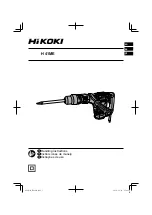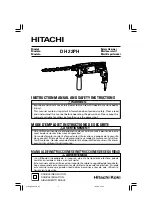
6
Selecting action mode
Rotation with hammering:
For drilling in concrete, granite, tile, etc., rotate the
change lever to the
P
position.
(Fig. 4)
Rotation only:
For drilling in wood or metal, rotate the change lever to
the
Q
position.
(Fig. 5)
CAUTION:
To avoid rapid wear on the mode change mechanism, be
sure that the change lever is always positively located in
one of the two action mode positions.
Switch action (Fig. 6)
CAUTION:
• Before plugging in the tool, always check to see that
the switch trigger actuates properly and returns to the
“OFF” position when released.
• Do not tape, tie or otherwise secure the trigger in the
“ON” position.
To start the tool simply pull the trigger. Tool speed is
increased by increasing pressure on the trigger. Release
the trigger to stop. A speed control screw is provided so
that maximum tool speed can be limited (variable). Turn
the speed control screw clockwise for higher speed, and
counterclockwise for lower speed.
Hammer drilling operation
Position the bit at the location for the hole, then pull the
trigger.
Do not force the tool. Light pressure gives best results.
Keep the tool in position and prevent it from slipping away
from the hole. Do not apply more pressure when the hole
becomes clogged with chips or particles. Instead, run the
tool at an idle, then remove from the hole. By repeating
this several times, the hole will be cleaned out.
CAUTION:
When the bit begins to break through concrete or if the
bit strikes reinforcing rods embedded in concrete, the tool
may react dangerously. Maintain good balance and safe
footing while holding the tool firmly with both hands to
prevent dangerous reaction.
Dust collector (Fig. 7)
Use the dust collector for safe, sanitary overhead opera-
tions. Install the bit, then attach the dust collector on the
end by turning and applying pressure. Then secure it by
turning the metal retainer clockwise.
CAUTION:
Empty the dust collector of its contents after drilling every
2 or 3 holes.
Drilling in wood or metal (Fig. 8)
Set the change lever for “rotation only”. Use the optional
drill chuck and chuck adapter for drilling up to 13 mm in
metal and up to 30 mm in wood. To install the drill chuck
and chuck adapter, refer to “Installing or removing drill
bit”.
CAUTION:
When the drill chuck is installed on this tool, do not use
“rotation with hammering” action. The drill chuck and
chuck adapter may be damaged.
MAINTENANCE
CAUTION:
Always be sure that the tool is switched off and
unplugged before carrying out any work on the tool.
Replacement of carbon brushes (Fig. 9)
Whenever carbon brushes must be replaced, they cut out
the tool automatically. When this occurs, replace both
carbon brushes at the same time. Use only identical car-
bon brushes.
Lubrication (Fig. 10 & 11)
This tool requires no hourly or daily lubrication because it
has a grease-packed lubrication system. Lubricate the
tool every time the carbon brushes are replaced.
Run the tool for several minutes to warm it up. Switch off
and unplug the tool. Remove the crank cap using a Mak-
ita lock nut wrench 35 (optional accessory). Rest the tool
on the table with the bit end pointing upwards. This will
allow the old grease to collect inside the crank housing.
Wipe out the old grease inside and replace with a fresh
grease (60 g). Use only Makita genuine grease (optional
accessory). Filling with more than the specified amount
of grease (approx. 60 g) can cause faulty hammering
action or tool failure. Fill only with the specified amount of
grease. Reinstall the crank cap and tighten with the lock
nut wrench. Do not tighten the crank cap excessively. It is
made of resin and is subject to breakage.
To maintain product safety and reliability, repairs, mainte-
nance or adjustment should be carried out by Makita
Authorized Service Center.
Содержание HR2510
Страница 2: ...2 1 2 3 4 5 6 7 8 ...
Страница 3: ...3 9 10 11 ...
Страница 32: ...Makita Corporation Anjo Aichi Japan Made in Japan 883436E979 ...




































